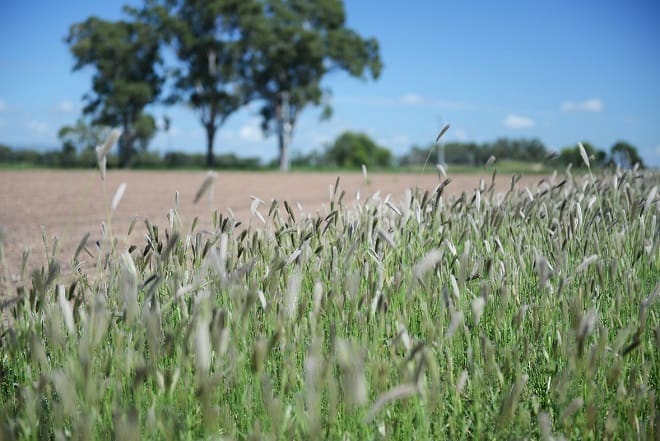
Feathertop Rhodes grass is one of the first weeds to establish on bare ground and can germinate on as little as 10mm of rain with emergence as rapid as two days later. It is fast maturing and can produce seed heads within four weeks if conditions are suitable. (Photo: GRDC)
AUTUMN rain could deliver more than grain growers are expecting – not just in rain gauges, but in the paddock, with falls likely to spark a flush of problem weeds, such as feathertop Rhodes grass (FTR).
Grains Research and Development Corporation (GRDC) crop protection officer – north, Vicki Green, said for some cropping regions of New South Wales and Queensland, wet weather following the dry summer was likely to prompt germinations.
Research has shown FTR (Chloris virgata) is often one of the first weeds to establish on bare ground and can germinate on as little as 10 millimetres of rain with emergence possible within two days.
It is a major weed of fallows and roadsides in Queensland and is becoming increasingly common in NSW.
Typically, FTR is perceived as an early spring, summer germinating weed, but with temperatures still in the ideal range for germination (20-30 degrees Celsius) growers need to be vigilant and check paddocks now for weed emergence.
Mrs Green said FTR control was increasingly challenging with confirmed cases of glyphosate resistant populations, forcing growers to rely on an integrated management strategy incorporating practices such as tillage, crop choice, crop competition, residual herbicides and the use of double knock applications in fallow.
“Growers’ first line of defence comes in understanding the characteristics and behaviour of FTR, so they can put an effective integrated management strategy into action,” she said.
“FTR favours germinating from the soil surface and, in favourable conditions, will rapidly produce large volumes of seed so populations can increase quickly. Therefore it is important growers monitor and manage for the weed, especially after even small rainfall events.”
Weed researcher Richard Daniel from Northern Grower Alliance said FTR control was a challenge and an integrated weed management strategy was critical in both fallow and crop situations.
“When developing an on-farm management strategy it is critical growers consider a range of options, including chemical and non-chemical measures,” Mr Daniel said.
“Glyphosate is not usually an effective tool for FTR management, so growers need to consider other options, including other knockdowns, such as some Group A herbicides.
“Although Group A herbicides are the key first knock treatment, growers need to be aware there may be plant-back risks if spraying in paddocks where they intend to plant winter cereals. In addition, Group A’s should always be double knocked with either another herbicide or a cultural method.”
Mr Daniel said at this time of year it was critical growers monitored paddocks for weed emergence after rain, with small actively growing FTR seedlings easier to control than larger or stressed weeds.
“An integrated management approach is the key to controlling FTR. This weed can germinate on minimal rainfall at temperatures between 20 and 30 degrees Celsius, and while it prefers lighter textured soils it will survive on heavier clays,” he said.
“It is also quick to mature and able to produce weed seeds within four weeks if the conditions are suitable.”
However, he said in terms of control it was important to understand the weed seed did not survive long on the soil surface or buried, generally lasting only 12-18 months before either germinating or losing viability.
“This means that although FTR is a difficult weed to manage, if you are able to limit seed production for even one season, the seedbank will rapidly drop and effective weed control can be achieved,” Mr Daniel said.
Tips for FTR control in autumn:
- Group A herbicides have a high risk of resistance developing, so only use them as part of a carefully considered IWM plan. If Group A is are no longer effective against FTR, all in-crop grass management options are lost.
- The double-knock tactic can be effective, and there are a number of available options.
- Target small, non-moisture stressed and actively growing plants to improve changes of good control. Spray small FTR seedlings immediately after rain.
- Use spot treatment for scattered or occasional FTR infestations.
- Adopt good herbicide application techniques to maximise coverage, for example using full label rates and appropriate equipment for the task.
- Use strategic tillage to control existing plants and ensure the depth and type of tillage is sufficient to uproot the grass without transplanting it.
- If using tillage for seed burial aim for burial below 5 centimetres.
- Manage outbreaks around roads and fence lines, otherwise these will be a continuing source of weed seed.
Source: GRDC
For more information on FTR, download a copy of the feathertop Rhodes grass fact sheet from the GRDC website: https://grdc.com.au/resources-and-publications/all-publications/factsheets/2013/09/feathertop-rhodes-grass.
For more information on control using Group A herbicides go to: https://grdc.com.au/resources-and-publications/all-publications/factsheets/2014/10/grdc-fs-groupainfallow


HAVE YOUR SAY